Saint-Gobain Bundle
Can Saint-Gobain Continue Its Centuries-Long Reign?
From the Hall of Mirrors at Versailles to sustainable construction solutions worldwide, Saint-Gobain's journey is a masterclass in strategic evolution. This global leader, born in 1665, has consistently adapted and innovated, securing its place at the forefront of the construction materials industry. Its impressive Saint-Gobain SWOT Analysis reveals the key to its enduring success.
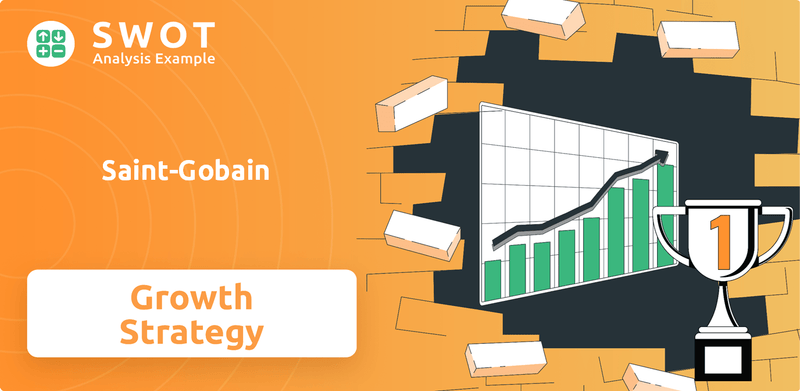
This in-depth Saint-Gobain company analysis delves into the core of its Saint-Gobain growth strategy, dissecting its market position and future prospects. We'll explore how Saint-Gobain plans to achieve sustainable growth through strategic initiatives, focusing on its business strategy for international expansion and its innovative approach to remain a leader in the face of evolving challenges. Understanding Saint-Gobain's financial performance and its response to environmental regulations is crucial for investors and strategists alike.
How Is Saint-Gobain Expanding Its Reach?
The Saint-Gobain growth strategy is significantly influenced by its expansion initiatives, focusing on strategic mergers, acquisitions, and market penetration. This approach is designed to strengthen its market position and capitalize on growth opportunities in various regions. The company's business strategy includes adapting to regional market conditions and investing in sectors like renovation, especially in markets where new construction is slowing down.
Saint-Gobain's future prospects are closely tied to its ability to integrate new acquisitions and drive organic growth. The company's decentralized structure allows for quick responses to market changes, ensuring resilience in different economic scenarios. Furthermore, the company continues to invest in innovation and sustainability, aligning with global trends in green building and environmental regulations.
As part of a comprehensive Saint-Gobain company analysis, it's important to examine its recent expansion efforts and their projected impact on its financial performance. These initiatives aim to enhance its presence in key markets and drive long-term value creation.
In 2024, the company completed four major acquisitions totaling €5 billion. These included CSR in Australia, Bailey in Canada, OVNIVER (Cemix brand) in Mexico and Central America, and FOSROC in India and the Middle East. These acquisitions are expected to boost sales and operating profit in 2025.
The company is focused on organic expansion in key markets, such as North America, where new plants are planned for mid-2025. The 'country-by-country model' enables quick adaptation to regional market conditions. In Europe, the renovation market, representing 60% of sales, offers stability.
The acquisitions are projected to add 3% to sales and €200 million to operating profit in 2025. The acquisition of OVNIVER Group is expected to generate revenues of $285 million with a growth rate of around 20% per year over the last five years, and an EBITDA margin of 21.7% in 2024.
The company is expanding its footprint in high-growth regions. North America has 58 U.S. plants and 33 Canadian facilities. Collaborations with universities and government institutions, such as in Singapore, support sustainability targets and innovation in green building.
Saint-Gobain's growth strategy includes strategic acquisitions, organic expansion, and a focus on key markets. These initiatives are designed to capitalize on market opportunities and strengthen its global presence. The company's decentralized model allows for flexibility and quick adaptation to regional market dynamics.
- Strategic Mergers and Acquisitions: Finalized four key acquisitions in 2024.
- Organic Expansion: Opening new plants in North America and focusing on the renovation market in Europe.
- Market Penetration: Targeting high-growth regions and adapting to local market conditions.
- Innovation and Sustainability: Collaborating on green building initiatives and supporting environmental regulations.
Saint-Gobain SWOT Analysis
- Complete SWOT Breakdown
- Fully Customizable
- Editable in Excel & Word
- Professional Formatting
- Investor-Ready Format
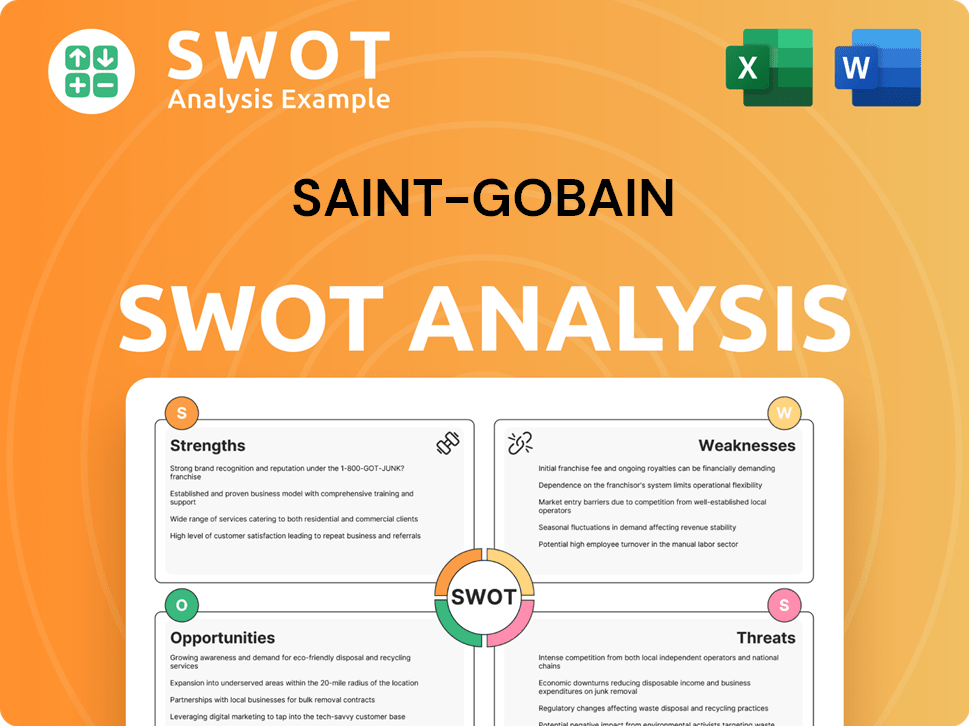
How Does Saint-Gobain Invest in Innovation?
The innovation and technology strategy of the company is central to its sustained growth, focusing heavily on research and development (R&D) and a commitment to sustainability. This approach is crucial for maintaining a strong market position and achieving long-term success. The company's dedication to technological advancements and sustainable practices positions it well for future opportunities.
The company's strategic investments in R&D and its focus on sustainable solutions are key drivers of its growth. By investing in cutting-edge technologies and environmentally friendly practices, the company aims to meet evolving customer needs and regulatory requirements. These initiatives are critical for navigating the challenges and capitalizing on the opportunities in the construction materials and related industries.
The company's innovation strategy includes a strong emphasis on digital transformation and the adoption of new technologies. This approach helps the company improve its operational efficiency, enhance its product offerings, and stay ahead of the competition. The company's commitment to innovation is evident in its investments in startups and its efforts to develop new, sustainable products.
In 2024, the company invested €600 million in R&D to drive its Saint-Gobain growth strategy. A significant portion, €251 million, was allocated to its carbon roadmap, demonstrating a commitment to sustainability.
The company supports its R&D efforts with a network of 3,800 researchers. These researchers are spread across 8 cross-functional R&D centers, fostering collaboration and innovation. This extensive network is crucial for developing new products and technologies.
In 2024, the company filed over 450 patents, showcasing its commitment to innovation and technological leadership. These patents cover a wide range of advancements. This high number of patent filings highlights its focus on creating proprietary technologies.
The company is dedicated to sustainable solutions and circular economy initiatives. It aims to reduce non-recyclable production waste by 80% by 2030. The company is also working to reduce industrial water withdrawals by 50% by 2030 compared to 2017 levels.
The company launched the world's first plasterboard made from 100% recycled gypsum in the UK. It also developed Oraé®, the world's first low-carbon glass, with 64% recycled content. These initiatives support its sustainability goals.
A joint project with SSAB in Raahe, Finland, aims to use ladle slag from steelmaking to create low-carbon binders. This reduces the carbon footprint of binders by up to 90% compared to traditional cements. This project is a key part of its sustainability efforts.
The company's venture capital arm, NOVA, invests in early-stage startups focused on sustainable building materials, circular economy solutions, and construction productivity tools. This strategic approach supports the company's Saint-Gobain future prospects.
- NOVA has invested in companies like Livspace for interior design and C-Cube for modular construction.
- In 2024, NOVA expanded its portfolio by adding startups like Renovate Robotics and Fortera.
- The CertainTeed Innovation Malvern R&D center is pursuing LEED Platinum certification, with plans to use 50% less water annually and achieve a 35% energy reduction.
- The company introduces innovative products such as FireLITE® (fire-resistant materials) and ClimateFlex® (weather-resistant roofing) to meet market needs and drive price increases.
Saint-Gobain PESTLE Analysis
- Covers All 6 PESTLE Categories
- No Research Needed – Save Hours of Work
- Built by Experts, Trusted by Consultants
- Instant Download, Ready to Use
- 100% Editable, Fully Customizable
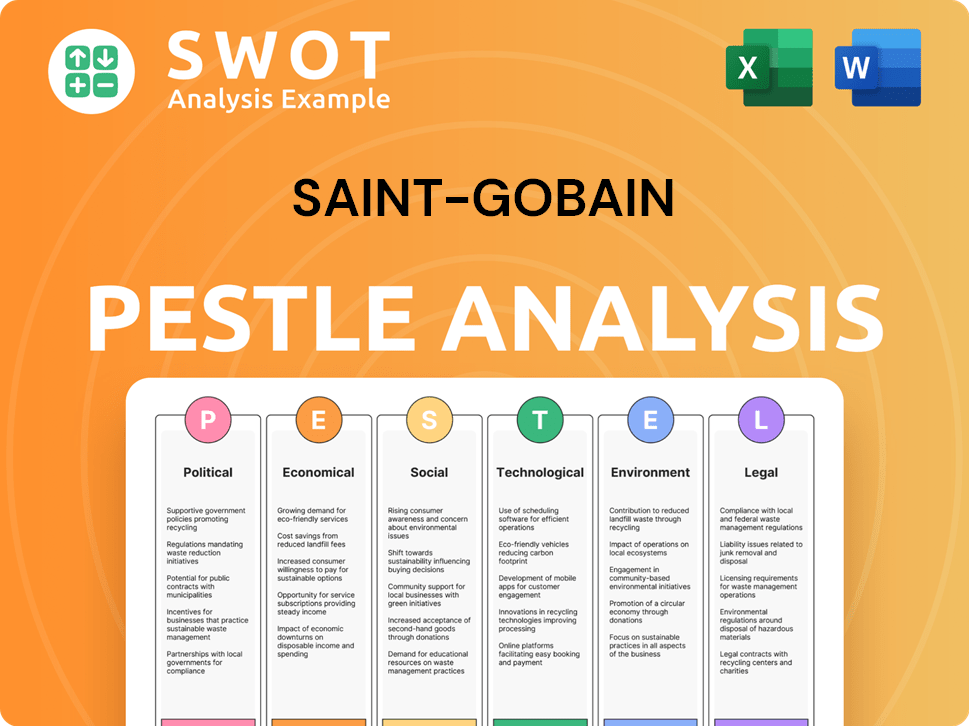
What Is Saint-Gobain’s Growth Forecast?
Saint-Gobain's financial outlook demonstrates a robust performance and strategic positioning for continued growth. The company has shown resilience in diverse economic conditions, reinforcing its ambitious goals. This positive trajectory is supported by a well-defined Saint-Gobain growth strategy and a focus on operational efficiency.
The company's strategic approach includes geographic diversification, with a significant portion of operating income now generated in high-growth areas. This diversification, combined with strategic acquisitions and disciplined pricing, has fueled sales growth. The company's financial strategy also prioritizes shareholder returns, as evidenced by its share buyback programs.
Looking at the future, Saint-Gobain's outlook remains positive, driven by its strategic initiatives and market dynamics. The company's ability to adapt and capitalize on market trends positions it well for sustainable expansion. For a deeper understanding of the competitive environment, one can explore the Competitors Landscape of Saint-Gobain.
In 2024, Saint-Gobain achieved record operating income of €5.30 billion, marking a 1% increase year-over-year. The operating margin reached a record of 11.4%. Free cash flow also hit a new high of €4.0 billion, with a conversion ratio of 62%.
Q1 2025 sales increased by 3.2% year-on-year to €11.7 billion. Acquisitions contributed 3.9% to sales growth, while price discipline added 0.8%. This indicates a strong start to the year, driven by strategic acquisitions and effective pricing strategies.
Over two-thirds of Saint-Gobain's pro forma operating income now comes from high-growth regions. The Americas and Asia-Pacific divisions achieved record margins of 18% and 12.6% respectively. This demonstrates the success of the company's international expansion strategy.
A new share buyback program with a €400 million target for 2025 reinforces shareholder returns. The company anticipates a gradual recovery in Europe's construction markets in the second half of 2025, while North America and Latin America are expected to maintain strong activity levels.
Saint-Gobain anticipates an operating margin exceeding 11.0% in 2025, surpassing its initial strategic plan objective of 9-11%. This indicates a positive outlook for Saint-Gobain's future prospects and its ability to achieve sustainable growth.
- Continued focus on high-growth regions.
- Strategic acquisitions to drive sales.
- Disciplined pricing strategies.
- Shareholder-focused financial policies.
Saint-Gobain Business Model Canvas
- Complete 9-Block Business Model Canvas
- Effortlessly Communicate Your Business Strategy
- Investor-Ready BMC Format
- 100% Editable and Customizable
- Clear and Structured Layout
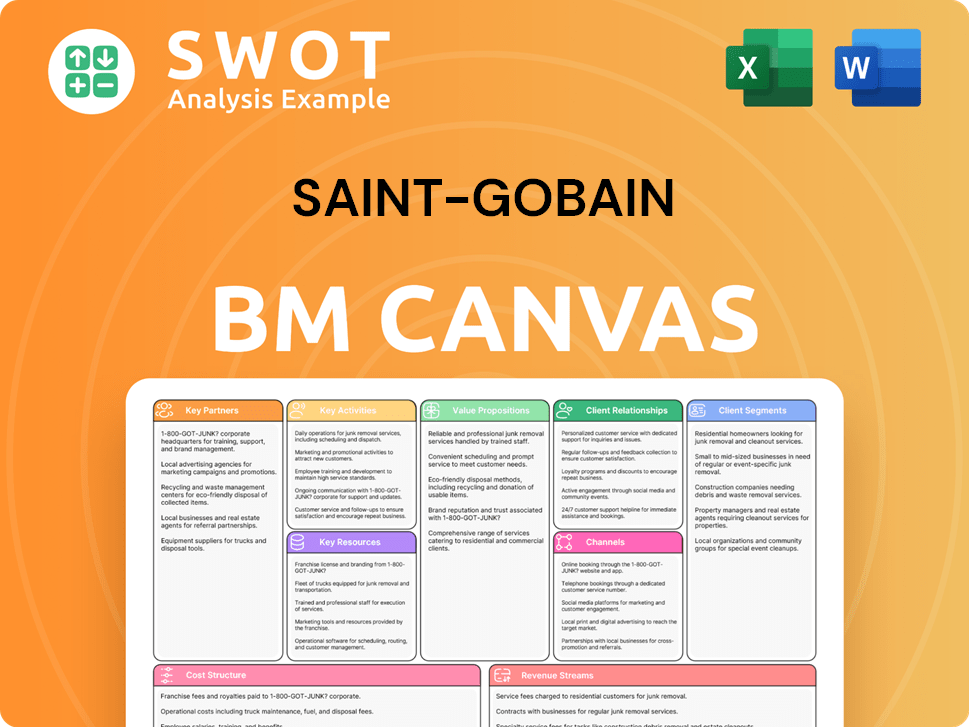
What Risks Could Slow Saint-Gobain’s Growth?
The strategic trajectory of Saint-Gobain, encompassing its Saint-Gobain growth strategy and Saint-Gobain future prospects, is interwoven with potential risks. These challenges include geopolitical instability, fluctuating input costs, and economic cycles in emerging markets. Understanding these obstacles is crucial for a comprehensive Saint-Gobain company analysis.
Geopolitical uncertainties, such as trade disputes and energy supply disruptions, pose a threat to regional economic recoveries. These factors, particularly in North America and China, could impact the demand for construction materials. While the company's decentralized structure helps to mitigate some supply chain issues, it remains exposed to these global challenges.
Inflationary pressures, specifically rising energy or raw material costs, can squeeze profit margins. However, Saint-Gobain's pricing strategies and innovative product mix offer a buffer against these pressures, as demonstrated by a 0.8% price increase globally in Q1 2025.
Geopolitical tensions, like trade disputes or energy supply disruptions, can hinder economic growth. These factors could weaken demand, particularly in regions like North America and China. The company's structure helps, but it still faces these global risks.
Rising energy and raw material costs can squeeze profit margins. Saint-Gobain's pricing strategies and innovative products help mitigate these pressures. In Q1 2025, the company implemented a 0.8% price increase globally.
Economic downturns in emerging markets, like China's real estate sector, pose challenges. Saint-Gobain adapts its strategy, such as focusing on the renovation sector in China. These cycles require flexible responses.
Environmental regulations, particularly those related to sustainability, present challenges. Saint-Gobain is committed to decarbonization and circular economy initiatives. The company aims for net-zero carbon emissions by 2050.
Labor shortages in the construction industry pose challenges, which are being addressed. Saint-Gobain offers solutions like 'ONE Precision Assemblies.' The company is also actively recruiting, with 1,200 new work-study offers in France for 2024-2025.
Saint-Gobain uses geographic diversification, strategic acquisitions, and high-value solutions to maintain resilience. These strategies help the company outperform its markets. The focus is on long-term sustainability.
Economic cycles in emerging markets, like China's real estate downturn and the uneven recovery in Latin America, present headwinds. To address these challenges, Saint-Gobain is adapting its strategies. For example, the company is pivoting towards the renovation sector in China to navigate market fluctuations effectively.
Regulatory changes, especially those related to environmental sustainability, are also a consideration. Saint-Gobain is actively committed to decarbonization and circular economy initiatives to meet evolving standards. The company aims to reduce CO2 emissions from scope 1 and 2 by 34% compared to 2017 and targets net-zero carbon emissions by 2050.
Internal resource constraints, such as labor shortages in the construction industry, are being addressed. Solutions include 'ONE Precision Assemblies' by CertainTeed, which streamlines construction processes. The company is actively recruiting, with 1,200 new work-study offers for 2024-2025 in France, across various sectors.
Saint-Gobain's proactive risk management framework includes geographic diversification and strategic acquisitions. The focus on high-value-added solutions helps maintain resilience. These strategies are designed to help the company outperform its markets and ensure long-term sustainability.
Saint-Gobain Porter's Five Forces Analysis
- Covers All 5 Competitive Forces in Detail
- Structured for Consultants, Students, and Founders
- 100% Editable in Microsoft Word & Excel
- Instant Digital Download – Use Immediately
- Compatible with Mac & PC – Fully Unlocked
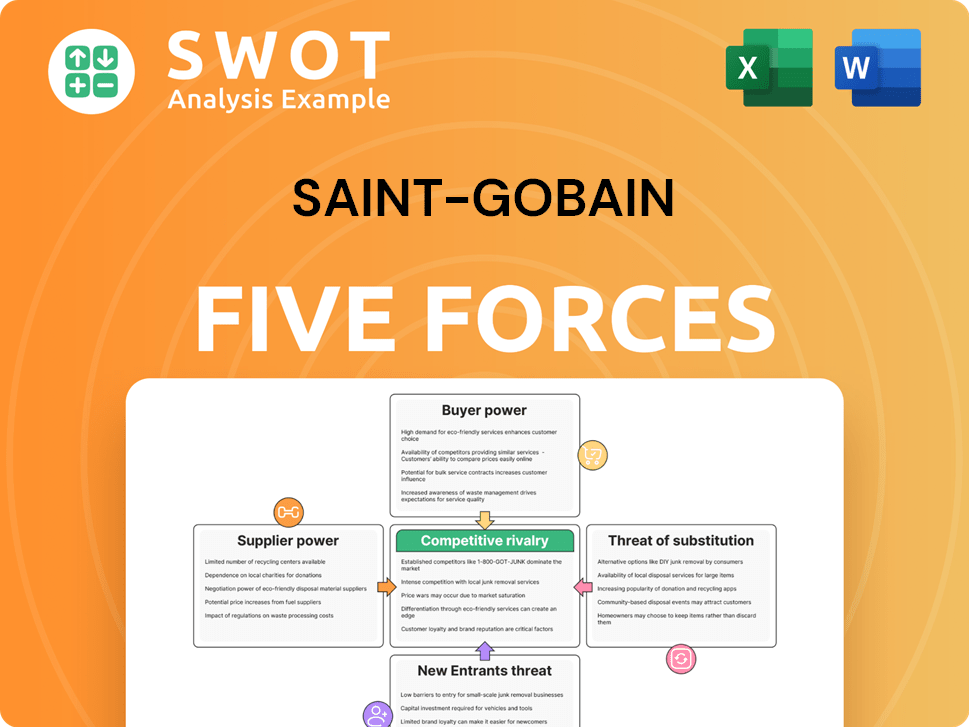
Related Blogs
- What are Mission Vision & Core Values of Saint-Gobain Company?
- What is Competitive Landscape of Saint-Gobain Company?
- How Does Saint-Gobain Company Work?
- What is Sales and Marketing Strategy of Saint-Gobain Company?
- What is Brief History of Saint-Gobain Company?
- Who Owns Saint-Gobain Company?
- What is Customer Demographics and Target Market of Saint-Gobain Company?
Disclaimer
All information, articles, and product details provided on this website are for general informational and educational purposes only. We do not claim any ownership over, nor do we intend to infringe upon, any trademarks, copyrights, logos, brand names, or other intellectual property mentioned or depicted on this site. Such intellectual property remains the property of its respective owners, and any references here are made solely for identification or informational purposes, without implying any affiliation, endorsement, or partnership.
We make no representations or warranties, express or implied, regarding the accuracy, completeness, or suitability of any content or products presented. Nothing on this website should be construed as legal, tax, investment, financial, medical, or other professional advice. In addition, no part of this site—including articles or product references—constitutes a solicitation, recommendation, endorsement, advertisement, or offer to buy or sell any securities, franchises, or other financial instruments, particularly in jurisdictions where such activity would be unlawful.
All content is of a general nature and may not address the specific circumstances of any individual or entity. It is not a substitute for professional advice or services. Any actions you take based on the information provided here are strictly at your own risk. You accept full responsibility for any decisions or outcomes arising from your use of this website and agree to release us from any liability in connection with your use of, or reliance upon, the content or products found herein.